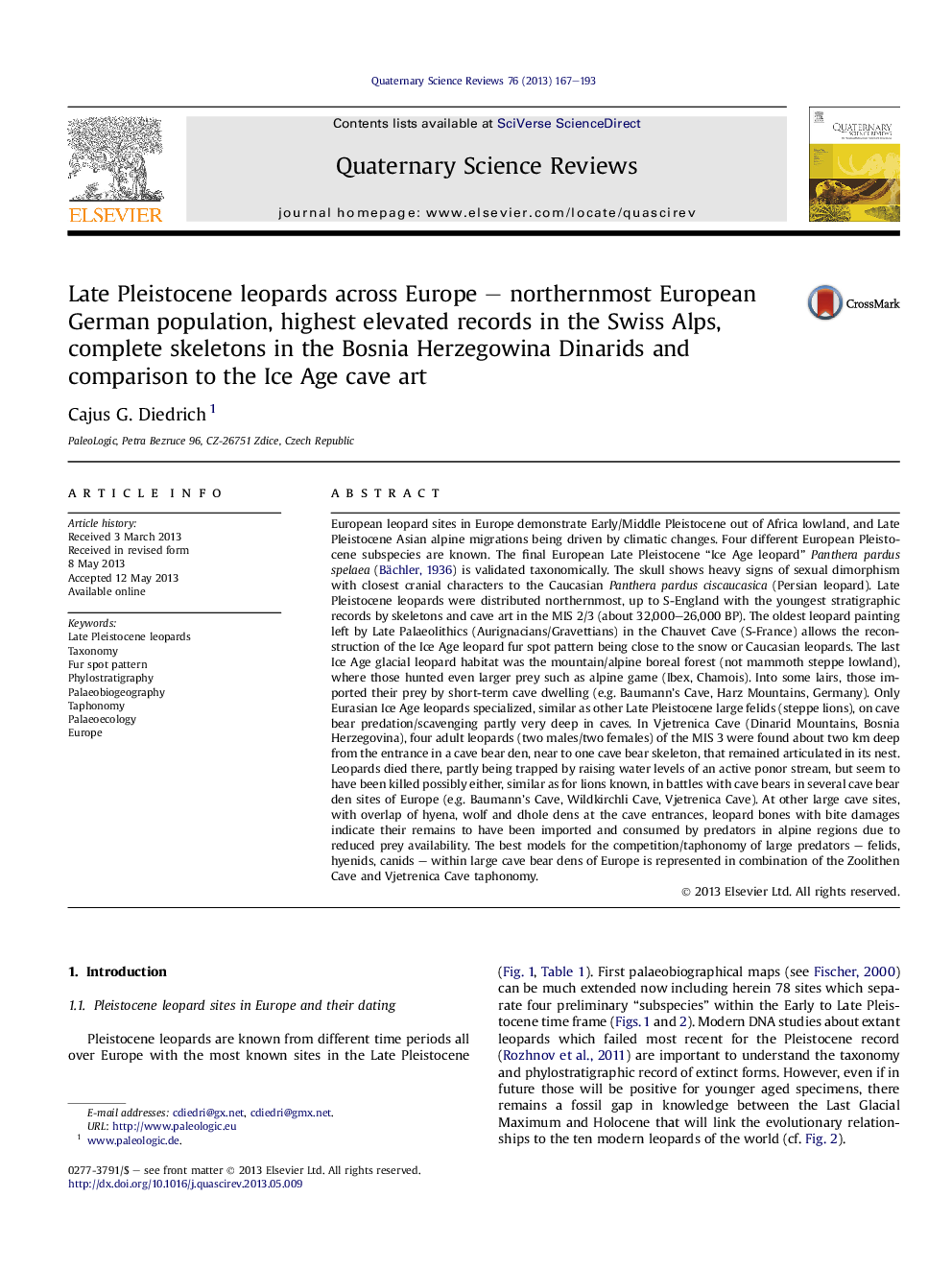| کد مقاله | کد نشریه | سال انتشار | مقاله انگلیسی | نسخه تمام متن |
|---|---|---|---|---|
| 6446703 | 1640858 | 2013 | 27 صفحه PDF | دانلود رایگان |
عنوان انگلیسی مقاله ISI
Late Pleistocene leopards across Europe - northernmost European German population, highest elevated records in the Swiss Alps, complete skeletons in the Bosnia Herzegowina Dinarids and comparison to the Ice Age cave art
ترجمه فارسی عنوان
لئونارد پیلیست کین در اواخر اروپا - جمعیت شمال اروپا اروپایی، بالاترین رکورد بالا در آلپ سوئیس، اسکلت کامل در دایناسورهای بوسنی هرزگوین و مقایسه آن با هنر عصر یخبندان
دانلود مقاله + سفارش ترجمه
دانلود مقاله ISI انگلیسی
رایگان برای ایرانیان
کلمات کلیدی
موضوعات مرتبط
مهندسی و علوم پایه
علوم زمین و سیارات
زمین شناسی
چکیده انگلیسی
European leopard sites in Europe demonstrate Early/Middle Pleistocene out of Africa lowland, and Late Pleistocene Asian alpine migrations being driven by climatic changes. Four different European Pleistocene subspecies are known. The final European Late Pleistocene “Ice Age leopard” Panthera pardus spelaea (Bächler, 1936) is validated taxonomically. The skull shows heavy signs of sexual dimorphism with closest cranial characters to the Caucasian Panthera pardus ciscaucasica (Persian leopard). Late Pleistocene leopards were distributed northernmost, up to S-England with the youngest stratigraphic records by skeletons and cave art in the MIS 2/3 (about 32,000-26,000Â BP). The oldest leopard painting left by Late Palaeolithics (Aurignacians/Gravettians) in the Chauvet Cave (S-France) allows the reconstruction of the Ice Age leopard fur spot pattern being close to the snow or Caucasian leopards. The last Ice Age glacial leopard habitat was the mountain/alpine boreal forest (not mammoth steppe lowland), where those hunted even larger prey such as alpine game (Ibex, Chamois). Into some lairs, those imported their prey by short-term cave dwelling (e.g. Baumann's Cave, Harz Mountains, Germany). Only Eurasian Ice Age leopards specialized, similar as other Late Pleistocene large felids (steppe lions), on cave bear predation/scavenging partly very deep in caves. In Vjetrenica Cave (Dinarid Mountains, Bosnia Herzegovina), four adult leopards (two males/two females) of the MIS 3 were found about two km deep from the entrance in a cave bear den, near to one cave bear skeleton, that remained articulated in its nest. Leopards died there, partly being trapped by raising water levels of an active ponor stream, but seem to have been killed possibly either, similar as for lions known, in battles with cave bears in several cave bear den sites of Europe (e.g. Baumann's Cave, Wildkirchli Cave, Vjetrenica Cave). At other large cave sites, with overlap of hyena, wolf and dhole dens at the cave entrances, leopard bones with bite damages indicate their remains to have been imported and consumed by predators in alpine regions due to reduced prey availability. The best models for the competition/taphonomy of large predators - felids, hyenids, canids - within large cave bear dens of Europe is represented in combination of the Zoolithen Cave and Vjetrenica Cave taphonomy.
ناشر
Database: Elsevier - ScienceDirect (ساینس دایرکت)
Journal: Quaternary Science Reviews - Volume 76, 15 September 2013, Pages 167-193
Journal: Quaternary Science Reviews - Volume 76, 15 September 2013, Pages 167-193
نویسندگان
Cajus G. Diedrich,
